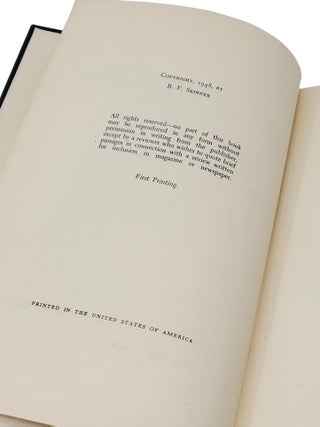Walden Two
Walden Two is a utopian novel written by behavioral psychologist B.F. Skinner and published in 1948. It presents a vision of a future experimental community where happiness and productivity are achieved through the application of behavioral engineering, a science of human behavior founded on the principles of operant conditioning. Both a response to Henry David Thoreau's Walden and a critique of other utopian novels, it sparked controversy and discussion upon its publication, given its advocacy for a society largely determined by conditioning rather than free will, creating as some have argued, an automaton dystopia where humans are treated like lab rats.
Hardcover. First Edition, First Printing. Octavo, black cloth. New York: The MacMillan Company, 1948. #10606.
Near fine with a very good dust jacket. While the corners of the front flap are clipped, the price remains intact. The jacket shows light edge wear, some rubbing along the spine, and minor chipping at the spine ends. Overall, this is a handsome and presentable copy of a seldom-found title.









B.F. Skinner's novel "Walden Two," written in 1948, presents a vision of a utopian community shaped by core principles of behavioral science. In the story, Professor Burris hears about Walden Two and decides to visit the experimental community firsthand. There he is introduced to the practices and principles of Walden Two by the community's founder, T.E. Frazier, where Skinner's behaviorist philosophies are applied to various societal facets like education, child-rearing, work dynamics, leisure, and governance.
The heart of Walden Two's societal framework revolves around four distinct occupational roles. The Planners form a six-member board responsible for overarching strategies and community welfare. The Managers supervise various labor sectors, ensuring smooth functioning. The Workers, who form the majority, engage in daily tasks and are compensated through a credit system based on the difficulty of their job. Lastly, Scientists stand at the community's innovative forefront, conducting experiments to continually refine the societal procedures. Noteworthy features of this community include its four-hour workday, collective child-rearing practices, non-traditional familial structures, and a commitment to the "Walden Code"—a guideline prioritizing communal values over individual achievements, aiming for an equilibrium between personal freedoms and collective well-being.
While Skinner's portrayal teeters on the utopian vision of a perfect society, many critics perceive Walden Two as distinctly dystopian. This critique predominantly stems from the novel's unwavering emphasis on behavioral modification—seen by some as an infringement on personal freedoms and individualism. The absence of democratic processes in leadership and the pervasive control over aspects like child upbringing magnify concerns about suppressed free will, threading a delicate balance between ideal societal harmony and potential dehumanization.
Despite its initial tepid reception, "Walden Two" saw a renewed popularity in the 1960s and 1970s, resonating with countercultural movements that embraced communal living and alternative societal blueprints. However, the novel remains a point of discussion in studies of dystopian literature. In "Dystopia: A Natural History", Gregory Claeys argues that the removal of children from their parents for the purpose of collective education, as well as the considerable groupthink and loss of individuality within the community are some of the traits lending Skinner's vision more to a dystopia than a utopia.
Burrhus Frederic Skinner (1904-1990) was an American psychologist, often regarded as the father of Behaviorism—a theory suggesting that human and animal behavior can be explained through conditioning. Throughout his career, Skinner posited that free will was an illusion and that human actions were determined by the consequences of previous actions, a concept he encapsulated in the principle of reinforcement.